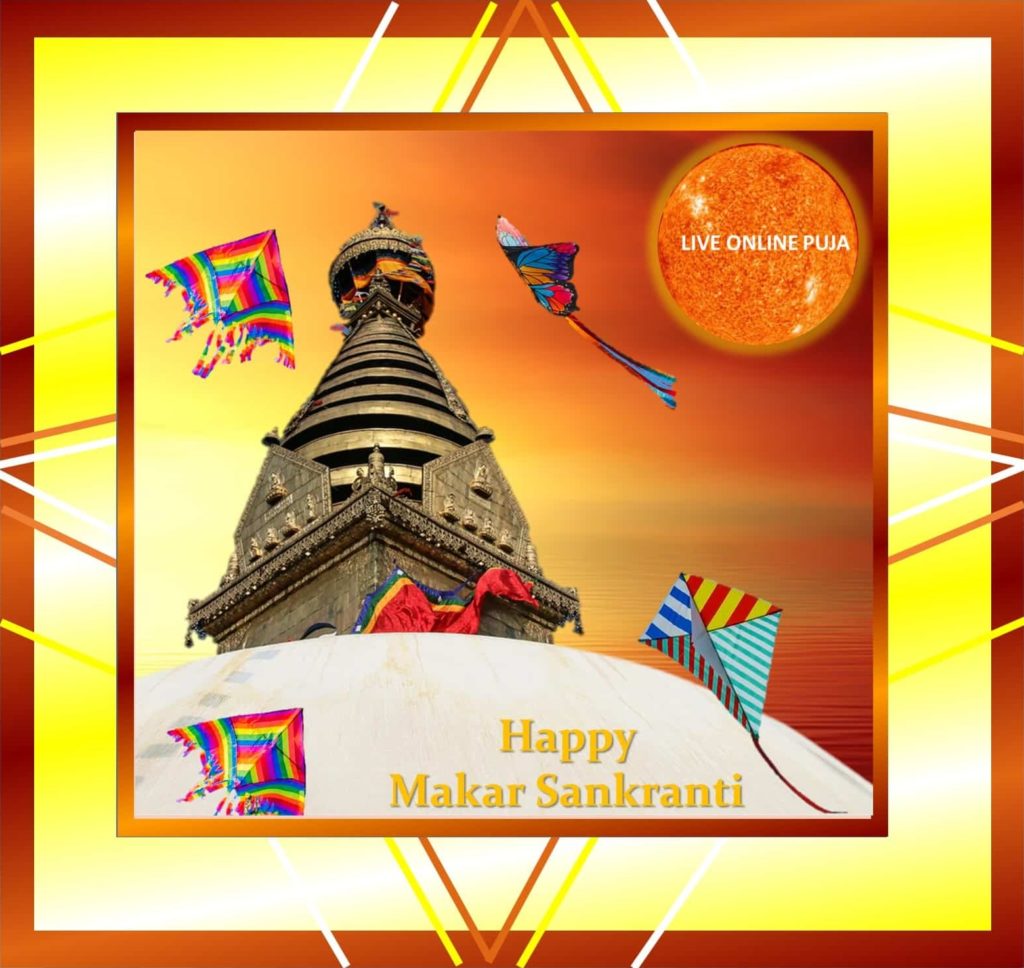
Menu

Celebrated by the Hindus on 14th or 15th January every year (the date being decided by the solar cycle), Makar Sankranti is celebrated with great joy and enthusiasm. The believers take an early morning dip in the holy rivers and offer their prayers to Surya Dev, the hindu Sun God.
The name of this festival is derived from two words, ‘Makar‘ and ‘Sankranti‘. Makar means Capricorn and Sankranti means transition. This festival, thus, is associated with the transition of the sun in the Capricorn (Zodiac), meaning the sun begins to move towards the north from its previous position in the southern hemisphere of the earth. The transition is considered so auspicious that it is celebrated as a full-fledged festival.
A legend behind its the name “Makar Sankranti” consists of a story of deity named Sankranti, who killed the demon Sankarasur and saved the people from his cruelties. It was in honour of this deity that this festival was named Makar Sankranti.
Trasit of sun into Capricorn is believed to be of sacred importance. It is due to this belief that taking a dip in the holy river Ganga is said to wash away the all the sins ever committed in life and make the soul pure and blessed. This festival also signifies an increase in spiritual light and a decrease in materialized darkness. While scientifically making the beginning of longer days and shorter nights.
Furthermore, taking the dip in the ‘Triveni Sangam’, the meeting of point of the holy rivers Ganga, Yamuna and Brahmaputra at Prayagraj, on the day of Makar Sankranti, is of divine importance in the Hindu culture. For this, a large scale gathering called the ‘Kumbh Mela’ is organized every year at Prayagraj. At this time if one takes a holy dip in the Sangam with the belief that all sins and obstacles in life will be washed away with the flow of the river.
A festival of harmony, humility, enjoyment and traditional delicacies – Makar Sankranti. The main delicacy of this festival is a dish made of Til and jaggery (gudd) that adds its own sparkles to the festival. Kite flying is also a great part of the festival during the day the whole family enjoys kite flying and at that time the sky is filled with a lot of colorful and different design kites. It is a wonderful scene to see the families and friends having fun together, each in their own unique way.
ALSO CHECKOUT
Some remedies specifically done on Makar Sakranti can Bring Prosperity, Good Health and Advancement in Career. Make sure you incorporate these into this auspicious day of today.
1. Bathing with holy water or water with sesame seeds is considered auspicious and helps to get rid of diseases.
2. Offering water to Sun with sesame seeds helps to attain blessings from Sun and brings success in career.
3. Donate food to Food Banks as well as in Temples to get the blessings of Surya Dev in your Career.
4. Donate Wheat, Rice, Flour, as well as, sweets made from Semsame (til) and Jaggery.

Charity is also a key part of this festival. Donation in the form of food grains like wheat, rice, flour and sweets mainly comprising of til and jaggery are given to the poor and needy people. It is said that one who donates on this day, God will bring happiness and prosperity in his life and remove any difficulties that he may face. Often, in regions such as Uttar Pradesh and Bihar, Khichdi is made and distributed among poor on Makar Sankranti. Moreover, donating new clothes, blankets, and other items of need to poor and elderly provides blessings of Surya Dev on the auspicious day of Makar Sankranti.
To conclude, we can say that it is a festival of great importance not only from a religious point of view but also from a scientific viewpoint. Happiness, joy and socializing with people is the spirit of the occasion. The true spirit of the festival is respectfulness and kindness towards others and living life in peace and harmony with the society.
Even though the Corona Virus has stopped us from socializing, we should not let the true spirit of this festival fade away and just find newer more unique ways to celebrate this festival Makar Sankranti, in its own way, reminds us to be sweet to people just like the til and jaggery that unites to form a mouthwatering delicacy prepared on this day.
Lohri is celebrated a day before Makar Sankranti, where people pray to Gods and celebrate by dancing and singing around a bonfire. The festival is primarily celebrated in Northern parts of India with great enthusiasm. Lohri is also called as the festival of harvest wherein farmers celebrate the end of sowing season and the start of harvesting season.
Makar Sankranti is a Hindu festival, which is celebrated across India in different forms, with great devotion and enthusiasm. This festival marks the start of longer days, is usually celebrated in the second week of January. It marks the end of the winter with the winter solstice and the start of longer days. It is known by many names depending on the region such as Magha Sankranti in Nepal, Magh Bihu in Assam, Maghi (preceded by Lohri) in Punjab, Haryana and Himachal Pradesh, Pongal in Tamil Nadu, Ghughuti in Uttarkhand.
Makar Sankranti is followed by Pongal. It is a four day long harvest festival celebrated in India which is associated with crop harvesting. This festival is celebrated in the month of January at the harvest crops like rice, turmeric and sugarcane. The festival is mainly celebrated in Tamil Nadu. Pongal is generally celebrated from 14 January to 17 January.
The annual harvest in Assam is marked by celebration of Bihu. People celebrate Rongali Bihu to mark the beginning of the Assamese New Year and the end of the harvesting season.